Magnetic resonance imaging of rectal cancer
- PMID: 20011416
- PMCID: PMC2780213
- DOI: 10.1055/s-2008-1080997
Magnetic resonance imaging of rectal cancer
Abstract
Magnetic resonance imaging (MRI)is a useful modality for the evaluation of rectal cancer, providing superior anatomic/pathologic visualization when compared with endorectal ultrasound (EUS) and computed tomography (CT). Preoperative MRI is useful for tissue characterization and tumor staging, which determines the surgical approach and need for neoadjuvant/adjuvant therapy. Important prognostic factors include the circumferential resection margin (CRM), T and N stages, and extent of local invasion. Postoperative MRI to assess the extent of tumor recurrence enables early resection, which can greatly prolong survival. MRI criteria for local recurrence include T2 hyperintensity, early dynamic rim enhancement, and nodular morphology. Future research in MRI of rectal cancer is geared toward developing optimal imaging techniques including high-resolution MRI, whole-body scans, and parallel imaging; imaging of lymph nodes by MR lymphography; and response to therapy using diffusion/perfusion-weighted MR and functional imaging.
Keywords: Magnetic resonance; postoperative; preoperative; rectal cancer; recurrence.
Figures

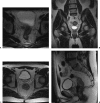
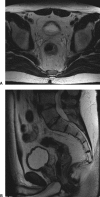

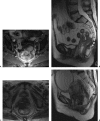
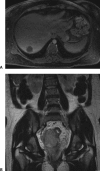

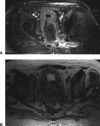
Similar articles
-
Current trends in staging rectal cancer.World J Gastroenterol. 2011 Feb 21;17(7):828-34. doi: 10.3748/wjg.v17.i7.828. World J Gastroenterol. 2011. PMID: 21412492 Free PMC article.
-
Correlation Between Endorectal Ultrasound and Magnetic Resonance Imaging for Predicting the Circumferential Resection Margin in Patients With Mid-Low Rectal Cancer Without Preoperative Chemoradiotherapy.J Ultrasound Med. 2020 Mar;39(3):569-577. doi: 10.1002/jum.15135. Epub 2019 Oct 16. J Ultrasound Med. 2020. PMID: 31617244
-
Endoscopic ultrasound and endorectal magnetic resonance imaging: a prospective, comparative study for preoperative staging and follow-up of rectal cancer.Endoscopy. 1995 Sep;27(7):469-79. doi: 10.1055/s-2007-1005751. Endoscopy. 1995. PMID: 8565885
-
[Clinical significance of preoperative magnetic resonance imaging in staging of rectal cancer].Korean J Gastroenterol. 2006 Apr;47(4):248-53. Korean J Gastroenterol. 2006. PMID: 16632974 Review. Korean.
-
Magnetic resonance imaging in rectal cancer.Magn Reson Imaging Clin N Am. 2014 May;22(2):165-90, v-vi. doi: 10.1016/j.mric.2014.01.004. Magn Reson Imaging Clin N Am. 2014. PMID: 24792676 Review.
Cited by
-
Endoscopic ultrasound in oncology: An update of clinical applications in the gastrointestinal tract.World J Gastrointest Endosc. 2017 Jun 16;9(6):243-254. doi: 10.4253/wjge.v9.i6.243. World J Gastrointest Endosc. 2017. PMID: 28690767 Free PMC article. Review.
-
Role of endoscopic ultrasonography in the loco-regional staging of patients with rectal cancer.World J Gastrointest Endosc. 2015 Jun 25;7(7):688-701. doi: 10.4253/wjge.v7.i7.688. World J Gastrointest Endosc. 2015. PMID: 26140096 Free PMC article. Review.
-
Magnetic resonance imaging based rectal cancer classification: landmarks and technical standardization.World J Gastroenterol. 2015 Jan 14;21(2):423-31. doi: 10.3748/wjg.v21.i2.423. World J Gastroenterol. 2015. PMID: 25593457 Free PMC article. Review.
-
Comparison of flexible endoscopy and magnetic resonance imaging in determining the tumor height in rectal cancer.Cancer Rep (Hoboken). 2023 Feb;6(2):e1705. doi: 10.1002/cnr2.1705. Epub 2022 Aug 17. Cancer Rep (Hoboken). 2023. PMID: 36806725 Free PMC article.
-
A tertiary care hospital's 10 years' experience with rectal ultrasound in early rectal cancer.Endosc Ultrasound. 2018 May-Jun;7(3):191-195. doi: 10.4103/eus.eus_15_17. Endosc Ultrasound. 2018. PMID: 28836512 Free PMC article.
References
-
- Hussain S M, Outwater E K, Siegelman E S. Mucinous versus nonmucinous rectal carcinomas: differentiation with MR imaging. Radiology. 1999;213(1):79–85. - PubMed
-
- Beets-Tan R G, Beets G L. Rectal cancer: review with emphasis on MR imaging. Radiology. 2004;232(2):335–346. - PubMed
-
- Iafrate F, Laghi A, Paolantonio P, et al. Preoperative staging of rectal cancer with MR imaging: correlation with surgical and histopathologic findings. Radiographics. 2006;26(3):701–714. - PubMed
-
- Lahaye M J, Lamers W H, Beets G L, Beets-Tan R GH. In: Di Falco G, Santoro GA, editor. Benign Anorectal Diseases: Diagnosis with Endoanal and Endorectal Ultrasound and New Treatment Options. New York, NY: Springer; 2006. MR Anatomy of the rectum and the mesorectum. pp. 67–77.

